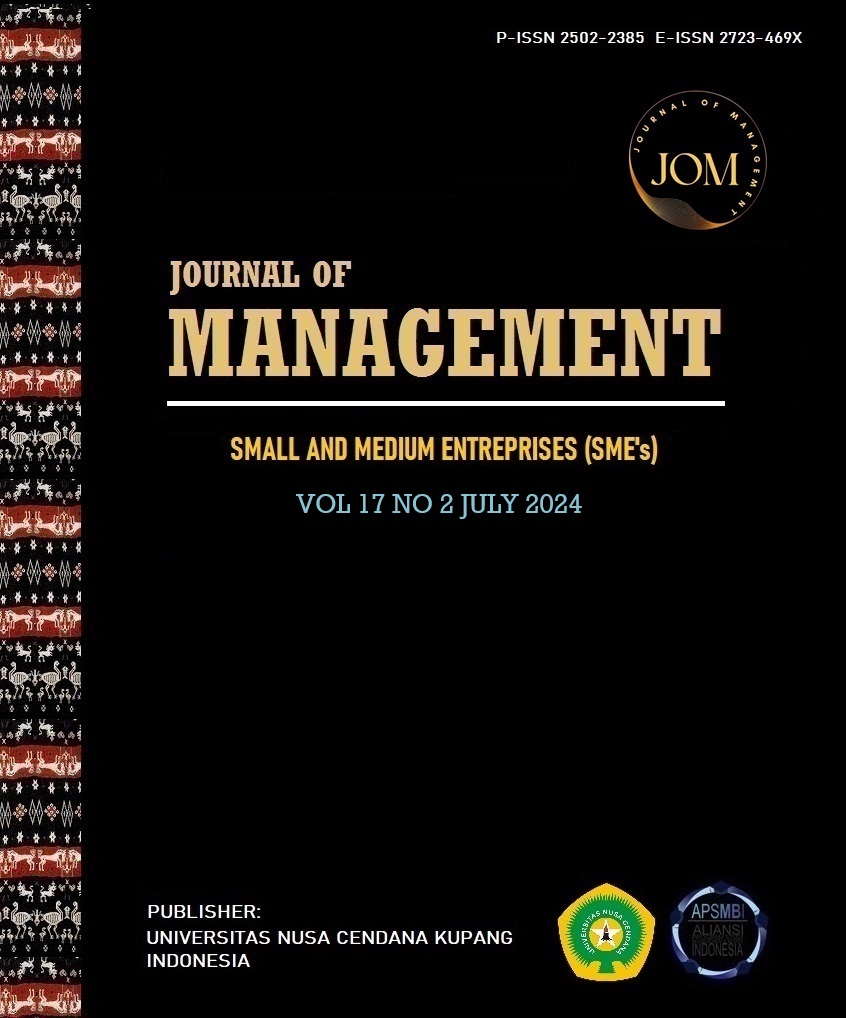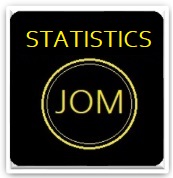IMPLEMENTATION OF AUGMENTED REALITY TECHNOLOGY FOR MARKETING STRATEGIES AND USER EXPERIENCE IN RETAIL SME INDONESIA
Abstract
This study investigates the impact of Augmented Reality (AR) technology on the customer experience at Miracle MacBook, contextualized within the Indonesian SME landscape. AR enhances user engagement by blending virtual elements with the physical world, offering an immersive shopping experience. The study uses interviews, observations, surveys, and analytical frameworks (STP, SWOT, Porter's Five Forces, VRIO, SDLC, and Augmented Reality Maturity Model) to assess the impact of AR as a business transformation. The results highlight the significant benefits of implementing AR to increase consumer engagement and loyalty in a competitive SME environment. The study recommends implementing AR technology to increase consumer trust and reduce reliance on price competition for Miracle MacBook and similar SMEs in Indonesia. Strategically integrating AR into online platforms can mitigate existing weaknesses and threats by enriching transactional experiences and differentiating brands through innovation. Recommendations include initiating AR pilot projects on websites with basic 3D interaction features, investing in advanced AR capabilities, and expanding AR applications to enhance customer service and marketing initiatives. Ongoing evaluation and training programs are essential to sustain AR innovation and meet evolving consumer demands. By strategically embracing AR, SMEs like Miracle MacBook can increase customer engagement, drive sales growth, and strengthen their market position amidst the digital transformation of Indonesia’s SME sector.
Keywords : Augmented Reality; User Experience; AR Prototype; Small Business Enterprise
Downloads
References
Balaji, S. (2019). Software Development Life Cycle (SDLC) for AR Integration. Journal of Software Engineering and Applications, 12(4), 85-92.
Bland, D. J., & Osterwalder, A. (2019). Testing business ideas: A field guide for rapid experimentation (Vol. 3). John Wiley & Sons.
Chaffey, D., & Ellis-Chadwick, F. (2019). Digital Marketing: Strategy, Implementation and Practice (7th ed.). Pearson.
Dobbs, M. E. (2014). Guidelines for applying Porter’s five forces framework: A set of industry analysis templates. Competitiveness Review, 24(1), 32-45.
Flavián, C., Ibáñez-Sánchez, S., & Orús, C. (2019). The impact of virtual, augmented and mixed reality technologies on the customer experience. Journal of Business Research, 100, 547-560.
Gartner. (2018). Hype Cycle for Emerging Technologies. Retrieved from https://www.gartner.com
Gupta, A., Rawal, A., & Barge, Y. (2021). Comparative Study of Different SDLC Models. International Journal for Research in Applied Science & Engineering Technology (IJRASET), 9(11), 73-80.
Huang, T. L., & Liao, S. (2015). A model of acceptance of augmented-reality interactive technology: The moderating role of cognitive innovativeness. Electronic Commerce Research, 15(2), 269-295.
Indrawati, H. (2020). Barriers to technological innovations of SMEs: how to solve them?. International Journal of Innovation Science, 12(5), 545-564.
Javornik, A. (2016). ‘It’s an illusion, but it looks real!’ Consumer affective, cognitive and behavioural responses to augmented reality applications. Journal of Marketing Management, 32(9-10), 987-1011.
Kang, B., Crilly, N., Ning, W., & Kristensson, P. O. (2023). Prototyping to elicit user requirements for product development: Using head-mounted augmented reality when designing interactive devices. Design Studies, 84, 101147.
Khan, M. E., Shadab, S. G. M., & Khan, F. (2020). Empirical study of Software Development Life Cycle and its Various Models. International Journal of Software Engineering (IJSE), 8(2), 169.
Kim, J. H., Kim, M., Park, M., & Yoo, J. (2023). Immersive interactive technologies and virtual shopping experiences: Differences in consumer perceptions between augmented reality (AR) and virtual reality (VR). Telematics and Informatics, 77, 101936.
Knott, P. J. (2015). Does VRIO help managers evaluate a firm’s resources?. Management Decision, 53(8), 1806-1822.
Laimeheriwa, I. B., & Kembau, A. S. (2024). Pengaruh Kepercayaan Akan Simulasi Virtual Try On terhadap Niat Beli di E-commerce. Syntax Literate; Jurnal Ilmiah Indonesia, 9(1), 241-257.
Leigh, D. (2009). SWOT analysis. Handbook of Improving Performance in the Workplace: Volumes 1‐3, 115-140.
Martins, N. C., Marques, B., Alves, J., Araújo, T., Dias, P., & Santos, B. S. (2022). Augmented reality situated visualization in decision-making. Multimedia Tools and Applications, 81(11), 14749-14772.
Mendoza-Ramirez, C. E., Tudon-Matinez, J. C., Felix-Herran, L. C., Lozoya-Santos, J. J., & Vargas-Martinez, A. (2023). Augmented Reality: Survey. Applied Sciences, 13(18), 10491. https://doi.org/10.3390/app131810491
Mills, K., & McCarthy, B. (2016). The state of small business lending: Innovation and technology and the implications for regulation. Harvard Business School Entrepreneurial Management Working Paper, (17-042), 17-042.
Parise, S., Guinan, P. J., & Kafka, R. (2016). Solving the crisis of immediacy: How digital technology can transform the customer experience. Business Horizons, 59(4), 411-420.
Pitts, B. (2018). Explore the Stage of the Augmented Reality Maturity Model. LinkedIn. Retrieved from https://www.linkedin.com/pulse/explore-stage-augmented-reality-maturity-model-p490e/
Poushneh, A., & Vasquez-Parraga, A. Z. (2017). Discernible impact of augmented reality on retail customer's experience, satisfaction and willingness to buy. Journal of Retailing and Consumer Services, 34, 229-234.
Porter, M. E. (2008). The Five Competitive Forces That Shape Strategy. Harvard Business Review.
Royce, W. (2019). Software Development Life Cycle (SDLC): Methods and Phases in detail. Journal of Software Engineering and Applications, 12(5), 85-92.
Scholz, J., & Smith, A. N. (2016). Augmented reality: Designing immersive experiences that maximize consumer engagement. Business Horizons, 59(2), 149-161.
Schumacher, A., Erol, S., & Sihn, W. (2016). A maturity model for assessing Industry 4.0 readiness and maturity of manufacturing enterprises. Procedia CIRP, 52, 161-166.
Splash, M. (2024). 100+ Statistik Augmented Reality (AR): Media Sosial, Pengguna & Pasar. Retrieved from https://marketsplash.com/statistik-augmented-reality/
Syed, T. A., Siddiqui, M. S., Abdullah, H. B., Jan, S., Namoun, A., Alzahrani, A., ... & Alkhodre, A. B. (2022). In-depth review of augmented reality: Tracking technologies, development tools, AR displays, collaborative AR, and security concerns. Sensors, 23(1), 146.
Thompson, A., Janes, A., Peteraf, M., Sutton, C., Gamble, J., & Strickland, A. (2020). EBOOK: Crafting and executing strategy: The quest for competitive advantage: Concepts and cases. McGraw Hill.
Ünal, C., Sungur, C., & Yildirim, H. (2022). Application of the Maturity Model in Industrial Corporations. Sustainability (Switzerland), 14(15).
https://doi.org/10.3390/su14159478
Urbaczewski, A., & Sauter, V. L. (2020). The augmented reality maturity model: Assessing organizational readiness. Journal of Information Technology Management, 31(2), 1-12.
Wang, H., Barney, J. B., & Reuer, J. J. (2019). Understanding the resource-based view: A framework for resource analysis. Strategic Management Journal, 40(10), 1-15.
Wang, X. (2019). Applying augmented reality in customer experience enhancement. Journal of Business Research, 101, 546-553.

 Ricky Fernando(1)
Ricky Fernando(1)



